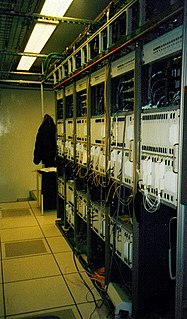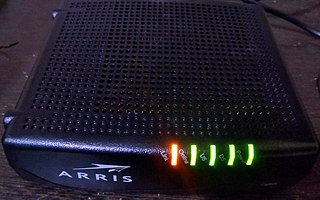Inverse Multiplexing for ATM (IMA) is a standardized technology used to transport ATM traffic over a bundle of T1 or E1 lines, which is called an IMA Group. This allows for gradual increase in data link capacity where implementing a higher capacity solution like T3/E3 or SONET/SDH is not deemed feasible. The maximum number of lines in an IMA Group is 32, bringing the total data rate to roughly 64 Mbit/s. The standard specification was initially approved by The ATM Forum in July 1997, and was later updated to version 1.1 in March 1999.
ATM cell insertion happens in the round robin fashion and is transparent for the terminal equipment on the ends of the link. IMA inverse multiplexing functionality requires some overhead (ICP or IMA Control Protocol cells, typically one ICP cell in every IMA frame—commonly 128 cells in length—and in CTC or Common Transmit Clock mode, an ICP stuff cell must be inserted after every 2048 cells), and an IMA sublayer on the physical layer.

Asynchronous Transfer Mode (ATM) is a telecommunications standard defined by ANSI and ITU standards for carriage of user traffic, including telephony (voice), data, and video signals. ATM was developed to meet the needs of the Broadband Integrated Services Digital Network, as defined in the late 1980s, and designed to integrate telecommunication networks. Additionally, it was designed for networks that must handle both traditional high-throughput data traffic, and real-time, low-latency content such as voice and video. The reference model for ATM approximately maps to the three lowest layers of the ISO-OSI reference model: network layer, data link layer, and physical layer. ATM is a core protocol used over the SONET/SDH backbone of the public switched telephone network (PSTN) and Integrated Services Digital Network (ISDN), but its use is declining in favour of all IP.

Frame Relay is a standardized wide area network technology that specifies the physical and data link layers of digital telecommunications channels using a packet switching methodology. Originally designed for transport across Integrated Services Digital Network (ISDN) infrastructure, it may be used today in the context of many other network interfaces.

Synchronous optical networking (SONET) and synchronous digital hierarchy (SDH) are standardized protocols that transfer multiple digital bit streams synchronously over optical fiber using lasers or highly coherent light from light-emitting diodes (LEDs). At low transmission rates data can also be transferred via an electrical interface. The method was developed to replace the plesiochronous digital hierarchy (PDH) system for transporting large amounts of telephone calls and data traffic over the same fiber without the problems of synchronization.
In computer networking, cell relay refers to a method of statistically multiplexing small fixed-length packets, called "cells", to transport data between computers or kinds of network equipment. It is an unreliable, connection-oriented packet switched data communications protocol.

A cable modem is a type of network bridge that provides bi-directional data communication via radio frequency channels on a hybrid fibre-coaxial (HFC), radio frequency over glass (RFoG) and coaxial cable infrastructure. Cable modems are primarily used to deliver broadband Internet access in the form of cable Internet, taking advantage of the high bandwidth of a HFC and RFoG network. They are commonly deployed in the Americas, Asia, Australia, and Europe.
The HomePNA Alliance is an incorporated non-profit industry association of companies that develops and standardizes technology for home networking over the existing coaxial cables and telephone wiring within homes, so new wires do not need to be installed.
An open standard is a standard that is publicly available and has various rights to use associated with it, and may also have various properties of how it was designed. There is no single definition and interpretations vary with usage.
Data Over Cable Service Interface Specification is an international telecommunications standard that permits the addition of high-bandwidth data transfer to an existing cable television (CATV) system. It is used by many cable television operators to provide Internet access over their existing hybrid fiber-coaxial (HFC) infrastructure. The version numbers are sometimes prefixed with simply "D" instead of "DOCSIS".
The Point-to-Point Protocol over Ethernet (PPPoE) is a network protocol for encapsulating PPP frames inside Ethernet frames. It appeared in 1999, in the context of the boom of DSL as the solution for tunneling packets over the DSL connection to the ISP's IP network, and from there to the rest of the Internet. A 2005 networking book noted that "Most DSL providers use PPPoE, which provides authentication, encryption, and compression." Typical use of PPPoE involves leveraging the PPP facilities for authenticating the user with a username and password, predominately via the PAP protocol and less often via CHAP.

CDMA2000 is a family of 3G mobile technology standards for sending voice, data, and signaling data between mobile phones and cell sites. It is developed by 3GPP2 as a backwards-compatible successor to second-generation cdmaOne (IS-95) set of standards and used especially in North America and South Korea.
The use of Asynchronous Transfer Mode (ATM) technology and services creates the need for an adaptation layer in order to support information transfer protocols, which are not based on ATM. This adaptation layer defines how to segment higher-layer packets into cells and the reassembly of these packets. Additionally, it defines how to handle various transmission aspects in the ATM layer.
The Radio Network Controller (RNC) is a governing element in the UMTS radio access network (UTRAN) and is responsible for controlling the Node Bs that are connected to it. The RNC carries out radio resource management, some of the mobility management functions and is the point where encryption is done before user data is sent to and from the mobile. The RNC connects to the Circuit Switched Core Network through Media Gateway (MGW) and to the SGSN in the Packet Switched Core Network.
In computer networking and telecommunications, a pseudowire is an emulation of a point-to-point connection over a packet-switching network (PSN).

IEEE 802.16 is a series of wireless broadband standards written by the Institute of Electrical and Electronics Engineers (IEEE). The IEEE Standards Board established a working group in 1999 to develop standards for broadband for wireless metropolitan area networks. The Workgroup is a unit of the IEEE 802 local area network and metropolitan area network standards committee.
In computer networking and telecommunications, TDM over IP (TDMoIP) is the emulation of time-division multiplexing (TDM) over a packet switched network (PSN). TDM refers to a T1, E1, T3 or E3 signal, while the PSN is based either on IP or MPLS or on raw Ethernet. A related technology is circuit emulation, which enables transport of TDM traffic over cell-based (ATM) networks.
If a network service wishes to use a broadband network to transport a particular kind of traffic, it must first inform the network about what kind of traffic is to be transported, and the performance requirements of that traffic. The application presents this information to the network in the form of a traffic contract.
The ATM Forum was founded in 1991 to be the industry consortium to promote Asynchronous Transfer Mode technology used in telecommunication networks; the founding president and chairman was Fred Sammartino of Sun Microsystems. It was a non-profit international organization. The ATM Forum created over 200 implementation agreements.
PME Aggregation Function (PAF) is a computer networking mechanism defined in Clause 61 of the IEEE 802.3 standard, which allows one or more Physical Medium Entities (PMEs) to be combined together to form a single logical Ethernet link.
International Mobile Telecommunications-Advanced are the requirements issued by the ITU Radiocommunication Sector (ITU-R) of the International Telecommunication Union (ITU) in 2008 for what is marketed as 4G mobile phone and Internet access service.
ATM Adaptation Layer 2 (AAL2) is an ATM adaptation layer for Asynchronous Transfer Mode (ATM), used primarily in telecommunications; for example, it is used for the Iu interfaces in the Universal Mobile Telecommunications System, and is also used for transporting digital voice. The standard specifications related to AAL2 are ITU standards I.363.2 and I366.1.





